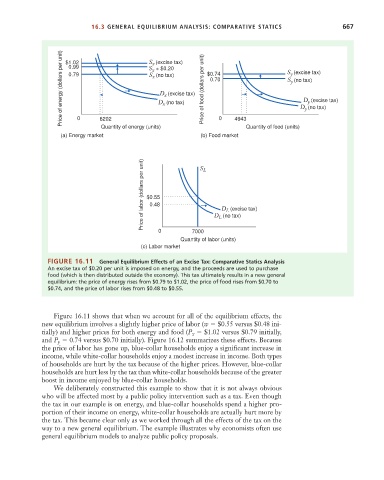Page 693 - Microeconomics, Fourth Edition
P. 693
c16GeneralEquilibriumTheory.qxd 8/16/10 9:13 PM Page 667
16.3 GENERAL EQUILIBRIUM ANALYSIS: COMPARATIVE STATICS 667
Price of energy (dollars per unit) $1.02 S (excise tax) Price of food (dollars per unit) $0.74 S (excise tax)
x
0.99
S + $0.20
x
y
0.79
S (no tax)
x
0.70
S (no tax)
y
D (excise tax)
x
D (excise tax)
y
D (no tax)
x
D (no tax)
0
6202
Quantity of energy (units) 0 4943 Quantity of food (units) y
(a) Energy market (b) Food market
Price of labor (dollars per unit) $0.55 S L D (excise tax)
0.48
L
L
0 7000 D (no tax)
Quantity of labor (units)
(c) Labor market
FIGURE 16.11 General Equilibrium Effects of an Excise Tax: Comparative Statics Analysis
An excise tax of $0.20 per unit is imposed on energy, and the proceeds are used to purchase
food (which is then distributed outside the economy). This tax ultimately results in a new general
equilibrium: the price of energy rises from $0.79 to $1.02, the price of food rises from $0.70 to
$0.74, and the price of labor rises from $0.48 to $0.55.
Figure 16.11 shows that when we account for all of the equilibrium effects, the
new equilibrium involves a slightly higher price of labor (w $0.55 versus $0.48 ini-
$1.02 versus $0.79 initially,
tially) and higher prices for both energy and food (P x
and P 0.74 versus $0.70 initially). Figure 16.12 summarizes these effects. Because
y
the price of labor has gone up, blue-collar households enjoy a significant increase in
income, while white-collar households enjoy a modest increase in income. Both types
of households are hurt by the tax because of the higher prices. However, blue-collar
households are hurt less by the tax than white-collar households because of the greater
boost in income enjoyed by blue-collar households.
We deliberately constructed this example to show that it is not always obvious
who will be affected most by a public policy intervention such as a tax. Even though
the tax in our example is on energy, and blue-collar households spend a higher pro-
portion of their income on energy, white-collar households are actually hurt more by
the tax. This became clear only as we worked through all the effects of the tax on the
way to a new general equilibrium. The example illustrates why economists often use
general equilibrium models to analyze public policy proposals.

